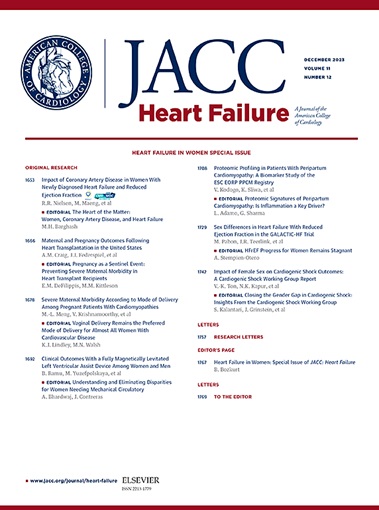Optimizing Triage of Ambulatory Patients With Advanced Heart Failure
IF 10.3
1区 医学
Q1 CARDIAC & CARDIOVASCULAR SYSTEMS
引用次数: 0
Abstract
Background
Left ventricular assist device (LVAD) use remains uncommon in advanced heart failure (HF) patients not dependent on inotropes.
Objectives
Before considering a randomized trial comparing a strategy of earlier use of LVAD to continued medical therapy, a better understanding is needed of the clinical trajectory of ambulatory patients with advanced systolic HF on optimal guideline-directed medical therapy (GDMT).
Methods
REVIVAL enrolled 400 patients with advanced ambulatory systolic HF, ≥1 HF mortality risk marker (≥2 HF hospitalizations past year; or HF hospitalization and high natriuretic peptide; or no HF hospitalizations but low peak oxygen consumption, 6-minute walk, serum sodium, HF survival score or Seattle HF model predicted survival), and no LVAD contraindication at 21 LVAD centers from July 2015 to June 2016. Patients were followed for 2 years or until a primary outcome (death, durable ventricular assist device, or urgent transplant). Clinical outcomes and health-related quality of life were evaluated.
Results
Mean baseline left ventricular ejection fraction was 21%, median 6-minute walk was 341 m, and 92% were Interagency Registry for Mechanically Assisted Circulatory Support profiles 5 to 7. Adherence to GDMT and electrical device therapies was robust. Composite primary outcome occurred in 22% and 37% at 1 and 2 years, with death alone in 8% and 16%, respectively. Patients surviving for 2 years maintained GDMT intensity and had no decline in health-related quality of life.
Conclusions
Structured, serial follow-up at programs with expertise in caring for advanced ambulatory systolic HF patients facilitates triage for advanced therapies. Better strategies are still needed to avoid deaths in a small but significant group of patients who die without advanced therapies. REVIVAL patients not selected for VAD or transplant have robust survival and patient-reported outcomes, which challenges advocacy for earlier VAD implantation. (Registry Evaluation of Vital Information for VADs in Ambulatory Life [REVIVAL]; NCT01369407)
优化门诊晚期心力衰竭患者的分流:REVIVAL 两年的研究结果。
背景:在不依赖肌力药物的晚期心力衰竭(HF)患者中,左心室辅助装置(LVAD)的使用仍不常见:在不依赖肌力药物的晚期心力衰竭(HF)患者中,左心室辅助装置(LVAD)的使用仍不常见:目的:在考虑进行一项随机试验,比较早期使用左心室辅助器与继续接受药物治疗的策略之前,需要更好地了解接受最佳指南指导药物治疗(GDMT)的非卧床晚期收缩性心力衰竭患者的临床轨迹:REVIVAL于2015年7月至2016年6月期间在21个LVAD中心招募了400名患有晚期非卧床收缩性心房颤动、≥1个心房颤动死亡风险标志物(过去一年≥2次心房颤动住院;或心房颤动住院且钠尿肽偏高;或无心房颤动住院但峰值耗氧量、6分钟步行、血清钠、心房颤动生存评分或西雅图心房颤动模型预测生存率偏低)且无LVAD禁忌症的患者。患者随访 2 年或直至出现主要结局(死亡、心室辅助装置失效或紧急移植)。对临床结果和健康相关生活质量进行了评估:平均基线左心室射血分数为21%,6分钟步行距离中位数为341米,92%的患者属于机构间机械辅助循环支持注册资料5至7级。GDMT和电动装置疗法的依从性良好。1年和2年后,分别有22%和37%的患者出现综合主要结局,其中仅死亡的比例分别为8%和16%。存活2年的患者保持了GDMT的强度,健康相关生活质量没有下降:结论:在专业护理晚期非卧床收缩性心房颤动患者的项目中进行结构化、连续性的随访,有利于对晚期患者进行分流。但仍需制定更好的策略,以避免一小部分未接受先进疗法的患者死亡。REVIVAL 未选择 VAD 或移植的患者具有良好的存活率和患者报告结果,这对倡导尽早植入 VAD 提出了挑战。(非卧床生活中的 VAD 生命信息登记评估 [REVIVAL];NCT01369407)。
本文章由计算机程序翻译,如有差异,请以英文原文为准。
求助全文
约1分钟内获得全文
求助全文
来源期刊

JACC. Heart failure
CARDIAC & CARDIOVASCULAR SYSTEMS-
CiteScore
21.20
自引率
2.30%
发文量
164
期刊介绍:
JACC: Heart Failure publishes crucial findings on the pathophysiology, diagnosis, treatment, and care of heart failure patients. The goal is to enhance understanding through timely scientific communication on disease, clinical trials, outcomes, and therapeutic advances. The Journal fosters interdisciplinary connections with neuroscience, pulmonary medicine, nephrology, electrophysiology, and surgery related to heart failure. It also covers articles on pharmacogenetics, biomarkers, and metabolomics.
 求助内容:
求助内容: 应助结果提醒方式:
应助结果提醒方式:


